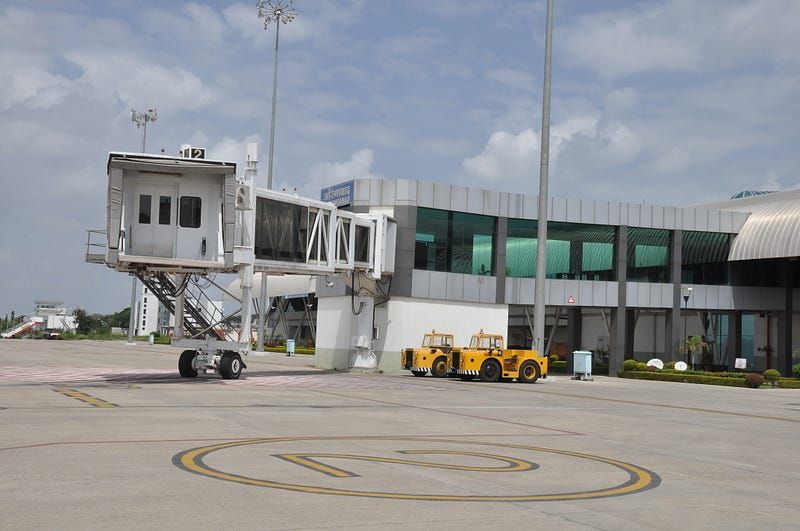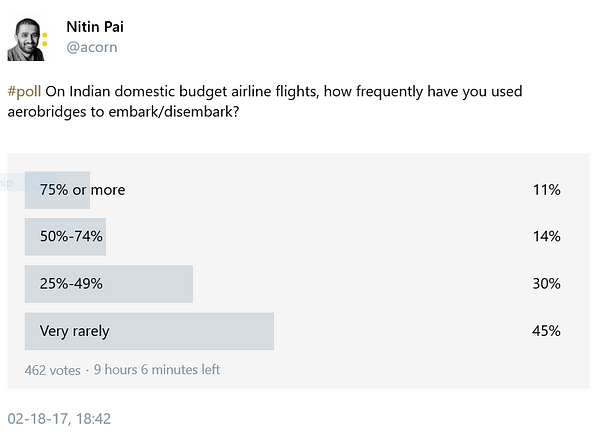Of buses and bridges.

To those flying low-cost carriers (or budget airlines) in India, the process of embarkation and disembarkation almost always involves a short bus ride between the airport terminal and the aircraft parked on the tarmac, and climbing up and down stairs with luggage.
A quick twitter poll I conducted last night supports my observation that the use of aerobridges (called “passenger boarding bridges”, in industry jargon) is not common, and the majority of budget flights ferry passengers to and from the aircraft using buses.

What I found intriguing is that buses are used despite there being a number of aerobridges available and vacant — at least in Bengaluru, Mumbai and Delhi airports that I use frequently. So I wanted to understand why this might be the case. I asked this question at the CNN Asia Business Forum panel in Bengaluru a few days ago, but didn’t get a satisfactory response.
Could the airports be charging extra for aerobridge use? Yes, a few years ago private airport operators like BIAL (now KIAL) in Bengaluru had unbundled their charges, and airlines had an option not to pay extra for aerobridge services. The listed charges for aerobridge use are around Rs 4000 per hour. Devesh Agrawal, an aviation analyst, estimates that aerobridge services would cost an airline around Rs 10,000 per flight including electrical and air-conditioning charges. The cost, he says, is significant enough to impact bottomlines of low-cost carriers.
This could be the reason why there was little take-up at that price, and despite aerobridges being available, some airlines didn’t want to use them. Now, Mr Agrawal says, some airports include aerobridge services in what they charge airlines, resulting in more budget airlines using them.
Aerobridges are more efficient in terms of the time it takes to turn around a flight. Even if a single door is used, aerobridges are much faster in getting passengers off and on the aircraft compared to buses. Since airlines only make money when the aircraft is in the air, reducing turn around times is important. In other words, it makes sense for airlines to use aerobridges if the savings from faster turn-around times are greater than the cost differential between aerobridges and buses. The aviation industry experts I checked with confirmed that this is indeed the case. (Trivia: I also found out that “outside-in” boarding, where window seat passengers board first, followed by middle and then aisle seat passengers, is the fastest way of filling a plane with passengers).
So why are buses still the most common way to get on and off the aircraft? Bharath Mahadevan, who runs the India operations of Scoot, says there is a shortage of aerobridges. The government-run Airports Authority of India has 117 aerobridges across 32 airports, and plans to install an additional 24 across the country. Private airports in Delhi, Mumbai, Bengaluru and Hyderabad have 250 among them.
According to DGCA, there were around 82,000 departures every month in 2016, and passenger traffic is growing at over 20% compared to the same month the previous year. On an average, assuming 18 operational hours a day, there are around 150 flights taking off each hour. Averages are not the best figures to assess traffic patterns, because of geographical and busy hour peaks. It is likely though, that there is a shortage of aerobridges; especially during peak hours.
Some media reports suggest that AAI plans to add 100 new aerobridges (this differs from the 24 mentioned earlier); private airports are also adding capacity. Like everything else in India, though, demand is likely to grow much faster than infrastructure. The buses, mobile staircases and ramps might not be going away soon.
A mostly unfree economy Next
Why New Delhi must institutionalise diaspora security
© Copyright 2003-2024. Nitin Pai. All Rights Reserved.